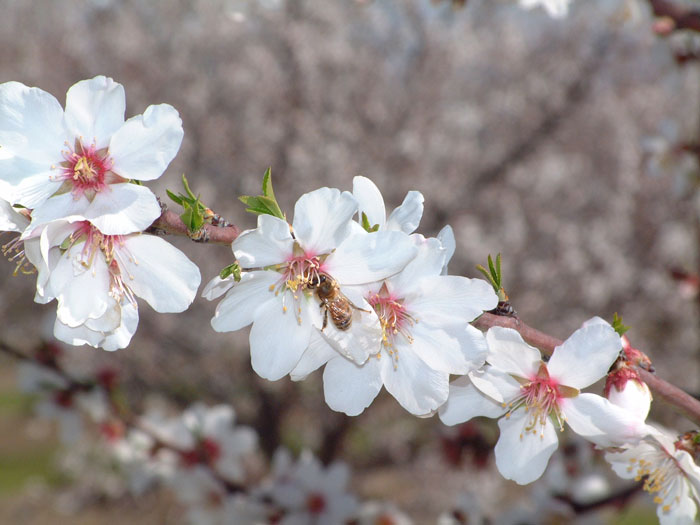January 20, 2016

Elizabeth Fichtner, a University of California farm advisor in Tulare County, wrote a research paper that opens with the provocative question, “Can Mechanically-Applied Pollen Either Supplement Bees or Ensure an Almond Crop in the Event of Bee Inefficacy or Unavailability? The answer?”
The answer seems to be simply “No.”
If bees, however challenged by weather and health, are at all helpful, applying pollen mechanically “won’t do a lot,” Fichtner said.
Reasons for this include the fact that the mechanical application is a one-shot deal. While bees that fly the orchards are out there for days a time, this increases the odds that blossoms will be more receptive to pollination when compared to the limited chances of that happening in the short span of a mechanical pollination.
“Only a small number of flowers are open when you apply the pollen. It’s a snapshot in time,” Fichtner said, compared to bloom which may take 14 days.
She added, “Conceptually, the application of pollen to trees by blowers relies on bee activity to redistribute pollen within the orchard. Only a small amount of the blown pollen would be deposited directly on receptive stigmas. Pollen is not viable for long.”
In the absence of bees for pollen redistribution, Fichtner says mechanical pollination achieves a random deposition of pollen on the tree. Bee pollination is a more directed form of pollen delivery since the bees specifically visit flowers.
Still, Fichtner says each year during almond bloom some growers try artificial pollination as either a supplement to bee pollination or an insurance policy against bee inefficiency.
It’s not a cheap way to go.
The cost is $300 or more an acre, says Joe Coelho, crop advisor and agronomist with Valley Orchard Management in Three Rocks, Calif. He worked with Fichtner and Tulare County staff research associate Katherine Wilson on the research project.
Coelho describes the almond orchard as remote from other almond orchards that could have been an added source of drifting or bee-transmitted pollen.
“It’s an area of jack rabbits and tumbleweeds,” he said.
For the project, Coelho says Valley Orchard supplied the manpower, tractors, and fuel. There were times, he says, when it was necessary to re-treat parts of the orchard. Overall, he found the results “not real positive” when it came to showing significant improvement in pollination.
Increasing almond acreage has increased the overall demand for hives, while chronic honey bee health issues limit hive supply. Interestingly, research into “blowing” pollen onto trees is hardly new. The research paper cites a 1966 research trial.
When asked why research might have been going on so long ago – before the health scourge for bees – Fichtner speculated it might have been because the almond industry was growing and was uncertain whether there would be the availability of the thousands of hives brought into the state from around the nation.
Several research studies have demonstrated that techniques for blowing pollen onto trees have no benefit as a supplement on fruit set or yield.
Fichtner said, “If you have good bee activity, there’s no benefit. It’s a total waste of money. In a rare event it could help.”
To address the efficacy of mechanical pollination as either a supplement or replacement of bees, replicated field trials were conducted in the southern San Joaquin Valley in 2014 and 2015.
Pollen, sourced from Wood Colony and Fritz varieties, was applied twice to test rows at 30-40 percent bloom and 50-60 percent bloom, and at three different experimental rates - 0, 23.5 and 70 grams per acre.
Nut set was measured in the Fritz and Monterey rows. There proved to be a higher nut set on the west than on the east side of the rows.
A 2015 study focused on Nonpareil and Monterey varieties. Three treatments were included: no mechanical or bee pollination, mechanical pollination only, plus bee and mechanical pollination.
Pollen was suspended in a Pollen-Tech proprietary liquid matrix applied with an electrostatic sprayer from Electrostatic Spraying Systems, Inc., Watkinsville, Ga.
For the no-pollination research, nylon mesh bags were placed over branches as bee barriers. Immediately prior to mechanical pollination, paper bags were placed over nylon mesh bags to prevent mechanically-applied pollen deposition on flowers.
Mesh bags were removed from branches for mechanical pollination only. Nylon bags were immediately replaced to prevent pollination.
Pollen was applied at approximately 60 percent bloom. Due to spray rig failure, full mechanical pollination was only achieved on the Monterey test row. No results were reported for Nonpareil.
Only a 1.3 percent nut set was achieved in the bee exclusion treatment. Mechanical pollination alone resulted in a 17 percent nut set. The bee-inclusion treatment, which included both bee pollination and any supplemental pollen distributed by mechanical pollination, resulted in 57 percent nut set.
Fichtner said the bee-exclusion study will be repeated in 2016, but 2014 results do not suggest that mechanical pollination significantly supplements bee pollination. She added that it is important to note that environmental conditions vary “between orchards and years.”
You May Also Like




